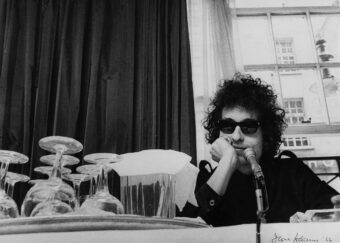The legacy of Run-D.M.C.’s legendary DJ, Jam Master Jay
With two turntables set on wreck, Jam Master Jay was one of hip-hop’s definitive b-boys. At 37, he had a lifetime of achievements behind him and alifetime of possibilities ahead of him. As Chuck D has said, Run-D.M.C. were the Beatles of rap, and Jam Master Jay was George Harrison and Ringo Starr combined, with a little Brian Epstein hustle thrown in. He left us too soon, but we can still say, “Goddamn, that DJ made my day!”
On November 4, outside the J. Foster Phillips Funeral Home in Jamaica, Queens, hundreds of cameramen, reporters, and fans braved the rain to gaze at a long line of mourners. Shoutouts erupted whenever a hip-hop celebrity like Grandmaster Flash arrived, and a few ill-mannered folks even handed out business cards. Metal police barricades separated the spectators from the official guests, and a tall, tight-faced officer ordered people around as if they were waiting to get into a rap concert. The sceneseemed like a parody of a celebrity wake.
Even inside the funeral home, there was a cartoonish aspect to the proceedings. Jason Mizell, 37, who was murdered on October 30, was laid in an open coffin, garbed as “Jam Master Jay”–black leather pants and jacket, shell-toe Adidas sneakers, a big black Stetson hat, and a thick gold chain with a miniature sneaker pendant. The tears in the viewing room, though, were for Jason, father of three, husband of 11 years, and longtime Queens resident. Yes, there were flowers from Jazzy Jeff and L.L. Cool J. Yes, Ad-Rock and MCA of the Beastie Boys stood against a wall looking dazed. But this was no photo-op grief. For the artists who were there when Run-D.M.C. lifted hip-hop out of the underground in the early 1980s, Mizell was a symbol of stability, maturity, and support. L.L. Cool J’s floral arrangement featured student written in red roses, a reflection of the fact that Mizell was a mentor to so many–not exactly a father figure, more like a very cool big brother.
Amid all the sad, downcast faces, two people were smiling. About 20 rows back from the body, the surviving members of Run-D.M.C.–Reverend Joseph “Run” Simmonsand Darryl “D.M.C.” McDaniels–were absolutely beaming as they talked of Mizell’s life and accomplishments. At first their good cheer was disturbing. How could two people who’d been friends with Mizell since childhood be so happy at his wake? But after listening to them for a moment, I found a smile crease my lips as well. The duo had already made a deeply spiritual peace with their comrade’s death.
Looking back at one of the most influential pop-music catalogs ever recorded, I thought of the countless Run-D.M.C. songs that referto God, the Devil, and the battle between faith and damnation. Rap has always been viewed as a break with the spiritually based black music known as soul and R&B. But perhaps we should reinterpret Run-D.M.C. as evangelists working in an avowedly secular form. Their ease with religious themes was obscured by the black leather and shouted, combative delivery until Run was ordained a minister inthe mid-’90s and D.M.C. traded his dookie chain for a crucifix.
Two days after the wake, Run-D.M.C. announced that they were retiring, which was both incredibly disheartening and quite appropriate. Contemporary hip-hop DJs serve mainly as ornamentation, but Jay was central to all of the trio’s breakthroughs (first rap group on MTV, first rap group on American Bandstand, and so on). From Run-D.M.C.’s first show at the Bronx’s legendary, cocaine-fueled Disco Feverto their recent dates opening for Aerosmith, Jay scratched, mixed vinyl live, and rapped behind the perpetually sore vocal chords of D.M.C. One of the last true “show DJs” working, he formed a bridge between the days when hip-hop meant a DJ and an MC in a New York City park and an age when truly creative “turntablists” exist in a parallel universe. Who DJs for Nas, Jay-Z, or Snoop? No one knows or cares. Imagining Run-D.M.C. onstage without Jam Master Jay is nearly impossible.
When I first met Run-D.M.C. in the early ’80s, Mizell was a teenager, but he had the presence of an adult. There was a sense of strength and reliability about him that everyone in the band’s circle noticed. While Run was flighty and dramatic and D.M.C. was occasionally withdrawn and a little too attached to his 40-ounce bottle of Olde English, Jason was the guy who pulled things together and looked out for everyone. He was also the most “gully” of the trio: Several people at the November 5 funeral noted that Mizell could hang with the B-boys and the nerds.
In Hollis and Jamaica, devastated fans are trading wildly different theories about Jay’s murder. But one consensus is that it’s disrespectful for the media to link it to the deaths of Tupac Shakur and the Notorious B.I.G. Those men, products of a younger rapgeneration, reported and celebrated thug life in their work and were surrounded by violence. But Mizell never engaged in gat talk on vinyl. His public persona was that of a family man and a vital elder statesman, one who was still discovering such new talent asthe rapper 50 Cent. Whether there was a darker side to his private life remains to be seen.
For 20 years, I saw Run-D.M.C. rock everything from Madison Square Garden to Las Vegas casinos. But my favorite image of Jay doesn’tinvolve turntables. Near the end of 1989’s “Run’s House” video, on some dark New York street, the camera tilts and the DJ–wearing the same gear in which he was buried–dances to the track’s James Brown beat. It’s a fleeting, funny moment that is both incredibly cool and sweetly goofy. It is my Jam Master Jay memory. Whenever the spirit moves you, try to remember yours.




